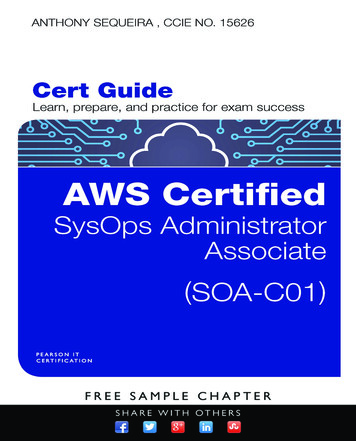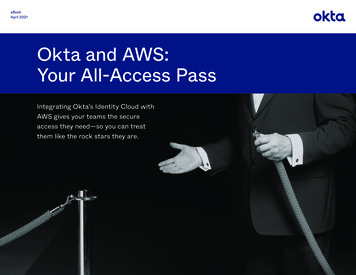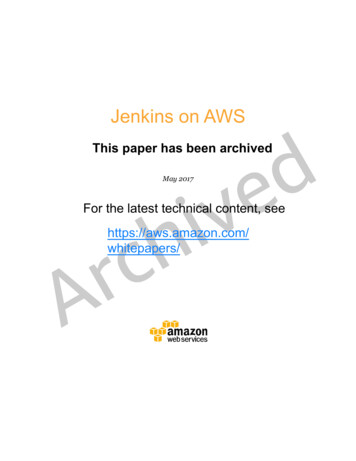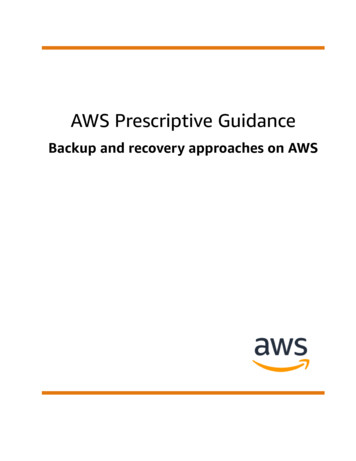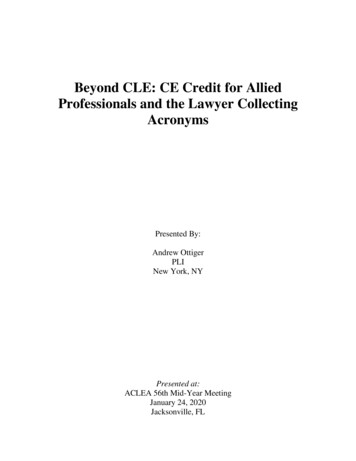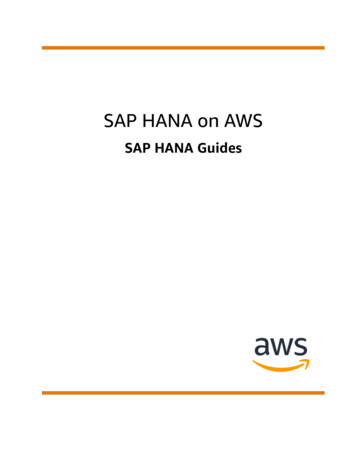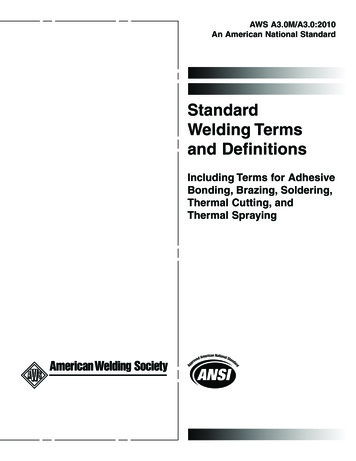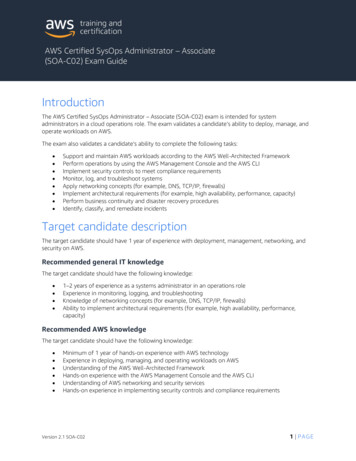
Transcription
AWS Certified SysOps Administrator – Associate(SOA-C02) Exam GuideIntroductionThe AWS Certified SysOps Administrator – Associate (SOA-C02) exam is intended for systemadministrators in a cloud operations role. The exam validates a candidate’s ability to deploy, manage, andoperate workloads on AWS.The exam also validates a candidate’s ability to complete the following tasks: Support and maintain AWS workloads according to the AWS Well-Architected FrameworkPerform operations by using the AWS Management Console and the AWS CLIImplement security controls to meet compliance requirementsMonitor, log, and troubleshoot systemsApply networking concepts (for example, DNS, TCP/IP, firewalls)Implement architectural requirements (for example, high availability, performance, capacity)Perform business continuity and disaster recovery proceduresIdentify, classify, and remediate incidentsTarget candidate descriptionThe target candidate should have 1 year of experience with deployment, management, networking, andsecurity on AWS.Recommended general IT knowledgeThe target candidate should have the following knowledge: 1–2 years of experience as a systems administrator in an operations roleExperience in monitoring, logging, and troubleshootingKnowledge of networking concepts (for example, DNS, TCP/IP, firewalls)Ability to implement architectural requirements (for example, high availability, performance,capacity)Recommended AWS knowledgeThe target candidate should have the following knowledge: Minimum of 1 year of hands-on experience with AWS technologyExperience in deploying, managing, and operating workloads on AWSUnderstanding of the AWS Well-Architected FrameworkHands-on experience with the AWS Management Console and the AWS CLIUnderstanding of AWS networking and security servicesHands-on experience in implementing security controls and compliance requirementsVersion 2.1 SOA-C021 PAG E
What is considered out of scope for the target candidate?The following is a non-exhaustive list of related job tasks that the target candidate is not expected to beable to perform. These items are considered out of scope for the exam: Design distributed architecturesDesign continuous integration and continuous delivery (CI/CD) pipelinesDesign hybrid and multi-VPC networkingDevelop softwareDefine security, compliance, and governance requirementsFor a detailed list of specific tools and technologies that might be covered on the exam, as well as lists ofin-scope and out-of-scope AWS services, refer to the Appendix.Exam contentResponse typesThere are three types of questions on the exam: Multiple choice: Has one correct response and three incorrect responsesMultiple response: Has two or more correct responses out of five or more response optionsExam lab: Has a scenario that is composed of a set of tasks to perform in the AWS ManagementConsole or AWS CLIMultiple choice and multiple response: Select one or more responses that best complete the statement oranswer the question. Distractors, or incorrect answers, are response options that a candidate withincomplete knowledge or skill might choose. Distractors are generally plausible responses that match thecontent area.All multiple-choice and multiple-response questions will appear at the start of the exam in one section. Theend of this section will include a review screen, where you can return to any of the multiple-choice andmultiple-response questions. This will be the last opportunity to answer the questions or change anyanswer selections. If your exam contains exam labs, that section will appear after the multiple-choice andmultiple-response section. You will NOT be able to go back to the first section after you start the secondsection.Exam labs: Complete the required tasks for a given scenario in the AWS Management Console or AWS CLIin the provided AWS account.When you begin your exam, you will receive notification about the number of questions in themultiple-choice and multiple-response section, and the number of exam labs in the exam lab section. Youwill also learn the percentage of your score that will be determined by your work in the exam labs. Plan toleave 20 minutes to complete each exam lab.Finish all work on an exam lab before you move to the next exam lab. You will NOT be able to return to aprior exam lab. You are welcome to use the virtual machine notepad or AWS CLI while working on yourexam labs.There might be more than one way to perform an exam lab. In those cases, you will receive full credit ifyou achieve the correct end state to the scenario. You will receive partial credit for partial completion ofVersion 2.1 SOA-C022 PAG E
exam labs. However, exam content and the associated scoring are confidential, so you will receive nofurther information regarding partial credit that is awarded for an exam lab.Tip: If you take your exam through online proctoring, you can use an external monitor as yourONLY display. Set your screen resolution to 1280 pixels x 1024 pixels or greater for a PC, and1440 pixels x 900 pixels or greater for a Mac. Set the scaling to 100%. Other settings might resultin a need to scroll within the console.On the exam, unanswered questions are scored as incorrect; there is no penalty for guessing. The examincludes 50 questions that affect your score. These questions include multiple-choice questions,multiple-response questions, and exam labs. Each scored multiple-choice question and each scoredmultiple-response question counts as a single scored opportunity. A scored exam lab includes multiplescored opportunities.For a sample of the multiple-choice and multiple-response questions and exam labs, see AWS CertifiedSysOps Administrator – Associate (SOA-C02) Sample Exam Questions.Unscored contentThe exam includes 15 unscored questions that do not affect your score. AWS collects information aboutcandidate performance on these unscored questions to evaluate these questions for future use as scoredquestions. These unscored questions are not identified on the exam.Exam resultsThe AWS Certified SysOps Administrator – Associate (SOA-C02) exam is a pass or fail exam. The exam isscored against a minimum standard established by AWS professionals who follow certification industrybest practices and guidelines.Your results for the exam are reported as a scaled score of 100–1,000. The minimum passing score is 720.Your score shows how you performed on the exam as a whole and whether or not you passed. Scaledscoring models help equate scores across multiple exam forms that might have slightly different difficultylevels.Your score report may contain a table of classifications of your performance at each section level. Thisinformation is intended to provide general feedback about your exam performance. The exam uses acompensatory scoring model, which means that you do not need to achieve a passing score in eachsection. You need to pass only the overall exam.Each section of the exam has a specific weighting, so some sections have more questions than othersections have. The table contains general information that highlights your strengths and weaknesses. Usecaution when interpreting section-level feedback.Content outlineThis exam guide includes weightings, test domains, and objectives for the exam. It is not a comprehensivelisting of the content on the exam. However, additional context for each of the objectives is available tohelp guide your preparation for the exam. The following table lists the main content domains and theirweightings. The table precedes the complete exam content outline, which includes the additional context.The percentage in each domain represents only scored content.Version 2.1 SOA-C023 PAG E
Domain% of ExamDomain 1: Monitoring, Logging, and Remediation20%Domain 2: Reliability and Business Continuity16%Domain 3: Deployment, Provisioning, and Automation18%Domain 4: Security and Compliance16%Domain 5: Networking and Content Delivery18%Domain 6: Cost and Performance Optimization12%TOTAL100%Domain 1: Monitoring, Logging, and Remediation1.1 Implement metrics, alarms, and filters by using AWS monitoring and logging services Identify, collect, analyze, and export logs (for example, Amazon CloudWatch Logs, CloudWatchLogs Insights, AWS CloudTrail logs) Collect metrics and logs using the CloudWatch agent Create CloudWatch alarms Create metric filters Create CloudWatch dashboards Configure notifications (for example, Amazon Simple Notification Service [Amazon SNS],Service Quotas, CloudWatch alarms, AWS Health events)1.2 Remediate issues based on monitoring and availability metrics Troubleshoot or take corrective actions based on notifications and alarms Configure Amazon EventBridge rules to trigger actions Use AWS Systems Manager Automation documents to take action based on AWS Config rulesDomain 2: Reliability and Business Continuity2.1 Implement scalability and elasticity Create and maintain AWS Auto Scaling plans Implement caching Implement Amazon RDS replicas and Amazon Aurora Replicas Implement loosely coupled architectures Differentiate between horizontal scaling and vertical scaling2.2 Implement high availability and resilient environments Configure Elastic Load Balancer and Amazon Route 53 health checks Differentiate between the use of a single Availability Zone and Multi-AZ deployments (forexample, Amazon EC2 Auto Scaling groups, Elastic Load Balancing, Amazon FSx, Amazon RDS) Implement fault-tolerant workloads (for example, Amazon Elastic File System [Amazon EFS],Elastic IP addresses) Implement Route 53 routing policies (for example, failover, weighted, latency based)Version 2.1 SOA-C024 PAG E
2.3 Implement backup and restore strategies Automate snapshots and backups based on use cases (for example, RDS snapshots, AWSBackup, RTO and RPO, Amazon Data Lifecycle Manager, retention policy) Restore databases (for example, point-in-time restore, promote read replica) Implement versioning and lifecycle rules Configure Amazon S3 Cross-Region Replication Execute disaster recovery proceduresDomain 3: Deployment, Provisioning, and Automation3.1 Provision and maintain cloud resources Create and manage AMIs (for example, EC2 Image Builder) Create, manage, and troubleshoot AWS CloudFormation Provision resources across multiple AWS Regions and accounts (for example, AWS ResourceAccess Manager, CloudFormation StackSets, IAM cross-account roles) Select deployment scenarios and services (for example, blue/green, rolling, canary) Identify and remediate deployment issues (for example, service quotas, subnet sizing,CloudFormation and AWS OpsWorks errors, permissions)3.2 Automate manual or repeatable processes Use AWS services (for example, OpsWorks, Systems Manager, CloudFormation) to automatedeployment processes Implement automated patch management Schedule automated tasks by using AWS services (for example, EventBridge, AWS Config)Domain 4: Security and Compliance4.1 Implement and manage security and compliance policies Implement IAM features (for example, password policies, MFA, roles, SAML, federated identity,resource policies, policy conditions) Troubleshoot and audit access issues by using AWS services (for example, CloudTrail, IAMAccess Analyzer, IAM policy simulator) Validate service control policies and permissions boundaries Review AWS Trusted Advisor security checks Validate AWS Region and service selections based on compliance requirements Implement secure multi-account strategies (for example, AWS Control Tower, AWSOrganizations)4.2 Implement data and infrastructure protection strategies Enforce a data classification scheme Create, manage, and protect encryption keys Implement encryption at rest (for example, AWS Key Management Service [AWS KMS]) Implement encryption in transit (for example, AWS Certificate Manager, VPN) Securely store secrets by using AWS services (for example, AWS Secrets Manager, SystemsManager Parameter Store) Review reports or findings (for example, AWS Security Hub, Amazon GuardDuty, AWS Config,Amazon Inspector)Version 2.1 SOA-C025 PAG E
Domain 5: Networking and Content Delivery5.1 Implement networking features and connectivity Configure a VPC (for example, subnets, route tables, network ACLs, security groups, NATgateway, internet gateway) Configure private connectivity (for example, Systems Manager Session Manager, VPCendpoints, VPC peering, VPN) Configure AWS network protection services (for example, AWS WAF, AWS Shield)5.2 Configure domains, DNS services, and content delivery Configure Route 53 hosted zones and records Implement Route 53 routing policies (for example, geolocation, geoproximity) Configure DNS (for example, Route 53 Resolver) Configure Amazon CloudFront and S3 origin access identity (OAI) Configure S3 static website hosting5.3 Troubleshoot network connectivity issues Interpret VPC configurations (for example, subnets, route tables, network ACLs, securitygroups) Collect and interpret logs (for example, VPC Flow Logs, Elastic Load Balancer access logs, AWSWAF web ACL logs, CloudFront logs) Identify and remediate CloudFront caching issues Troubleshoot hybrid and private connectivity issuesDomain 6: Cost and Performance Optimization6.1 Implement cost optimization strategies Implement cost allocation tags Identify and remediate underutilized or unused resources by using AWS services and tools (forexample, Trusted Advisor, AWS Compute Optimizer, Cost Explorer) Configure AWS Budgets and billing alarms Assess resource usage patterns to qualify workloads for EC2 Spot Instances Identify opportunities to use managed services (for example, Amazon RDS, AWS Fargate, EFS)6.2 Implement performance optimization strategies Recommend compute resources based on performance metrics Monitor Amazon EBS metrics and modify configuration to increase performance efficiency Implement S3 performance features (for example, S3 Transfer Acceleration, multipart uploads) Monitor RDS metrics and modify the configuration to increase performance efficiency (forexample, Performance Insights, RDS Proxy) Enable enhanced EC2 capabilities (for example, enhanced network adapter, instance store,placement groups)Version 2.1 SOA-C026 PAG E
AppendixWhich key tools, technologies, and concepts might be covered on the exam?The following is a non-exhaustive list of the tools and technologies that could appear on the exam. This listis subject to change and is provided to help you understand the general scope of services, features, ortechnologies on the exam. The general tools and technologies in this list appear in no particular order.AWS services are grouped according to their primary functions. While some of these technologies will likelybe covered more than others on the exam, the order and placement of them in this list is no indication ofrelative weight or importance: AnalyticsApplication IntegrationAWS Cost ManagementComputeContainersDatabaseManagement, Monitoring, and GovernanceMigration and TransferNetworking and Content DeliverySecurity, Identity, and ComplianceStorageAWS services and featuresAnalytics: Amazon Elasticsearch Service (Amazon ES)Application Integration: Amazon EventBridge (Amazon CloudWatch Events) Amazon Simple Notification Service (Amazon SNS) Amazon Simple Queue Service (Amazon SQS)AWS Cost Management: AWS Cost and Usage Report AWS Cost Explorer Savings PlansCompute: AWS Application Auto Scaling Amazon EC2 Amazon EC2 Auto Scaling Amazon EC2 Image Builder AWS LambdaDatabase: Amazon Aurora Amazon ElastiCache Amazon RDSVersion 2.1 SOA-C027 PAG E
Management, Monitoring, and Governance: AWS CloudFormationAWS CloudTrailAmazon CloudWatchAWS Command Line Interface (AWS CLI)AWS Compute OptimizerAWS ConfigAWS Control TowerAWS License ManagerAWS Management ConsoleAWS OpsWorksAWS OrganizationsAWS Personal Health DashboardAWS Secrets ManagerAWS Service CatalogAWS Systems ManagerAWS Systems Manager Parameter StoreAWS tools and SDKsAWS Trusted AdvisorMigration and Transfer: AWS DataSync AWS Transfer FamilyNetworking and Content Delivery: AWS Client VPN Amazon CloudFront Elastic Load Balancing AWS Firewall Manager AWS Global Accelerator Amazon Route 53 Amazon Route 53 Resolver AWS Transit Gateway Amazon VPC Amazon VPC Traffic MirroringSecurity, Identity, and Compliance: AWS Certificate Manager (ACM) Amazon Detective AWS Directory Service Amazon GuardDuty AWS IAM Access Analyzer AWS Identity and Access Management (IAM) Amazon Inspector AWS Key Management Service (AWS KMS) AWS License Manager AWS Secrets Manager AWS Security HubVersion 2.1 SOA-C028 PAG E
AWS ShieldAWS WAFStorage: Amazon Elastic Block Store (Amazon EBS)Amazon Elastic File System (Amazon EFS)Amazon FSxAmazon S3Amazon S3 GlacierAWS BackupAWS Storage GatewayOut-of-scope AWS services and featuresThe following is a non-exhaustive list of AWS services and features that are not covered on the exam.These services and features do not represent every AWS offering that is excluded from the exam content.Services or features that are entirely unrelated to the target job roles for the exam are excluded from thislist because they are assumed to be irrelevant.Out-of-scope AWS services and features include the following: Amazon API GatewayAmazon AppStream 2.0AWS BatchAmazon ChimeAmazon Cloud DirectoryAmazon CloudSearchAWS CodeBuildAWS CodeCommitAWS CodeDeployAWS CodeStarAmazon ConnectAWS Deep Learning AMIs (DLAMI)AWS Device FarmAmazon DynamoDBAmazon DynamoDB Accelerator (DAX)Amazon Elastic Container Registry (Amazon ECR)Amazon Elastic Container Service (Amazon ECS)Amazon Elastic TranscoderAmazon EMRAmazon GameLiftAWS IoT ButtonAWS IoT GreengrassAWS IoT PlatformAmazon KinesisAmazon LexAmazon LightsailAmazon LumberyardAmazon Machine Learning (Amazon ML)Version 2.1 SOA-C029 PAG E
AWS Managed ServicesAWS Mobile HubAWS Mobile SDKApache MXNet on AWSAmazon PinpointAmazon PollyAmazon RedshiftAmazon RekognitionAWS Schema Conversion ToolAmazon Simple Email Service (Amazon SES)AWS SnowmobileAmazon WorkDocsAmazon WorkMailAmazon WorkSpacesAWS X-RayVersion 2.1 SOA-C0210 PAG E
The AWS Certified SysOps Administrator – Associate (SOA-C02) exam is a pass or fail exam. The exam is scored against a minimum standard established by AWS professionals who follow certification industry best practices and guidelines. Your results for the exam are reported as a sca

